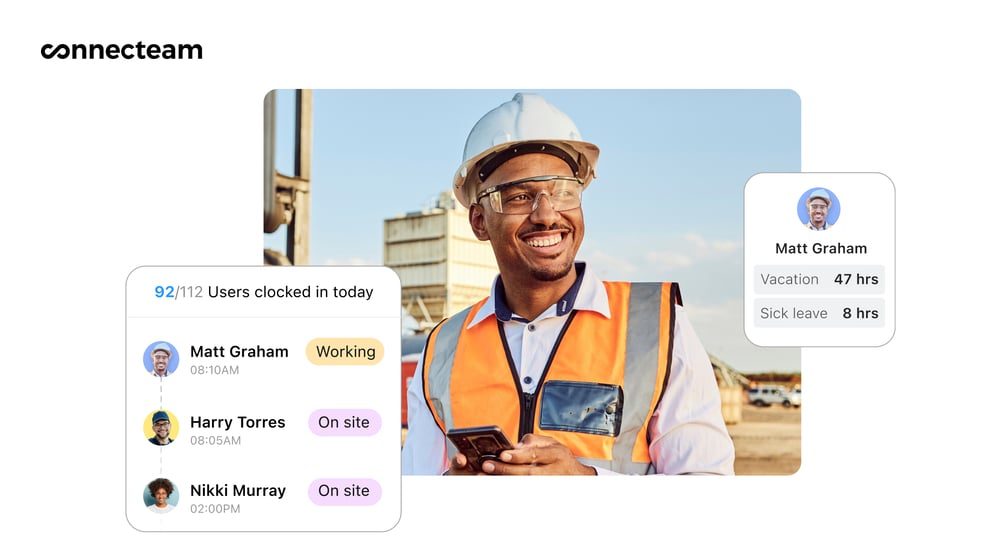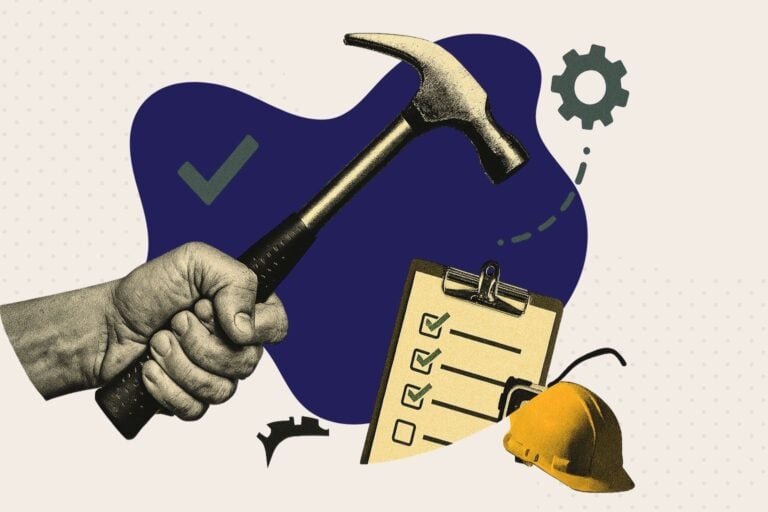Starting a construction business means making smart equipment investments from day one, but knowing which tools are truly essential versus nice-to-haves can make or break your budget.
Getting your tool inventory right is one of the biggest decisions you’ll make when starting a construction business. Buy too little, and you’ll find yourself constantly borrowing equipment or turning down jobs. Buy too much, and you’ll drain your startup capital on tools that sit unused.
In this guide, we’ll break down exactly what construction tools and supplies you need to get started, organized by category and priority level.
Key Takeaways
- A well-equipped construction site includes reliable tools, essential consumables, and proper protective gear to keep crews productive and safe.
- Implement clear processes like check-in/out logs, regular inspections, and reorder points to avoid shortages, losses, and costly delays.
- Digital tools such as mobile forms, checklists, and team chat make it easier to track inventory, manage equipment use, and coordinate in real time.
What Tools Do You Need on a Construction Site? A Master Checklist
Every construction business needs a core set of reliable tools and supplies to operate efficiently and safely. The specific mix depends on your specialty, but certain categories are universal across trades.
Here’s your complete breakdown of what construction supplies are needed on site. If you’re starting from scratch, our guide on what you need to start a construction company can help you plan your tools, supplies, and other essentials from day one.
Essential hand tools
These are the tools your team will reach for multiple times every day across virtually every type of project. They’re relatively affordable, incredibly durable, and don’t require power sources or maintenance beyond basic care.
Core hand tools for construction include:
- Tape measure (25-30 ft): Used for measuring lumber, layouts, and spacing on site. Choose a 25-30-ft tape with a wide standout and magnetic hook for easier solo measurements.
- Hammer (claw and framing): Drives and removes nails during framing, finish work, and demolition. Look for a curved claw hammer for general use and a heavier framing hammer for structural work.
- Screwdrivers (flathead & Phillips, multi-bit preferred): Used for fastening or removing screws in fixtures, electrical boxes, and hardware. A multi-bit screwdriver with magnetic tips and an ergonomic handle saves space and improves grip.
- Utility knife + spare blades: Cuts drywall, insulation, tape, and packaging. Choose a retractable utility knife with quick blade change and keep extra blades on hand to avoid dull cuts.
- Speed square: Helps mark angles, check corners, and guide cuts. A 7-inch square is ideal for framing and roof work and fits easily in your tool pouch.
- Chalk line: Marks long, straight reference lines on plywood, subfloors, or walls. Look for a durable case, a metal hook, and brightly colored chalk for better visibility.
- Torpedo level: Checks plumb and level in tight spaces like outlets or trim installs. A magnetic torpedo level with three vials (horizontal, vertical, 45°) is a versatile choice.
- Pry bar / flat bar: Used for removing trim, pulling nails, and separating materials. Go for a forged steel bar with beveled edges and nail slots for maximum leverage.
- Wrenches (adjustable and combo sets): Tighten and loosen bolts, pipe fittings, and fasteners. Keep both adjustable and combination wrench sets to cover various sizes.
- Pliers (needle nose, groove joint, cutting): Grip, twist, and cut wires or hold small parts in place. A three-piece set covers most jobsite needs, including electrical and plumbing work.
- Hand saw: Makes quick cuts in wood or PVC without needing power. Choose a 15-20-inch general-purpose saw with a hardened tooth blade for smooth cuts.
Pro Tip
Look for combo tool sets from reputable brands like DeWalt, Milwaukee, or Makita. Buying complete kits usually costs 20%-30% less than purchasing individual tools, and you’ll get a carrying case included.
When managing a crew, use mobile communication tools to coordinate who brings what tools to each jobsite, preventing duplicates and ensuring nothing gets forgotten.
Power tools
Power tools increase speed, precision, and efficiency on any jobsite. Most are now available in cordless versions, which improve safety and mobility. Corded tools still offer better power for longer tasks and are often more budget-friendly.
Must-have power tools
- Drill/driver combo: Used for drilling holes and driving screws into wood, metal, or masonry. Look for variable speed, adjustable clutch settings, and at least a 20V lithium-ion battery system.
- Impact driver: Provides high torque for driving large fasteners like lag bolts or long deck screws. A brushless motor and quick-change chuck improve durability and ease of use.
- Circular saw: Makes straight cuts in lumber, plywood, and sheathing. Choose a 7-¼-inch blade with depth adjustment and a beveling shoe for angled cuts.
- Reciprocating saw (Sawzall): Cuts through framing, pipes, nails, and demolition material. Opt for a tool-free blade change, adjustable shoe, and orbital action setting for faster cuts.
- Oscillating multi-tool: Handles tight cuts, detail sanding, and flush trim work. A cordless version with universal blade compatibility offers the most flexibility.
- Angle grinder: Used for cutting metal, grinding welds, and smoothing surfaces. Look for adjustable guards, a paddle switch, and a side handle for control.
- Rotary hammer: Drills into concrete, brick, or masonry for anchors and bolts. Choose an SDS-Plus or SDS-Max chuck depending on the type of work you do.
Nice-to-have power tools
- Miter saw: Makes quick, clean angle cuts in trim, studs, or decking. A 10- or 12-inch compound sliding model increases versatility.
- Table saw: Rips long boards and sheet goods like plywood. Look for a portable jobsite model with a rack-and-pinion fence and folding stand.
- Framing/finish nailer: Drives nails faster and more accurately than a hammer. Cordless models reduce compressor use; choose framing or finish based on your primary tasks.
Did You Know?
Sticking with one battery platform across all your cordless tools can save you hundreds of dollars in battery and charger costs. Most major brands offer 50+ tools that share the same battery system.
Safety and protective gear
Construction sites present daily hazards—from flying debris and sharp edges to noise and respiratory risks. Personal protective equipment (PPE) is essential for preventing injuries and staying OSHA-compliant.
- Hard hat: Protects the head from falling tools or materials. Choose a Type I or II hard hat that meets ANSI Z89.1 (industrial head protection) and fits securely with an adjustable suspension.
- Safety glasses (and anti-fog versions): Shield the eyes from dust, sparks, and chemical splashes. Look for ANSI-rated lenses and anti-fog coatings, especially in humid environments.
- Hearing protection (earplugs or earmuffs): Prevents hearing damage from loud tools or machinery over 85 dB. Use earmuffs for ongoing use, and disposable plugs for quick protection.
- Dust mask or respirator (based on job type): Protects lungs from sawdust, paint fumes, and silica dust. Use N95 or half-mask respirators with replaceable filters for better protection.
- High-visibility vest or shirt: Makes workers visible near traffic or heavy equipment. Choose ANSI Class 2 or 3 garments with reflective striping for best visibility.
- Durable work gloves: Protect hands from sharp edges, abrasions, and chemicals. Match glove types to the task—cut-resistant for framing, nitrile for handling adhesives.
- Steel/composite toe boots: Prevents foot injuries from impacts and punctures. Composite toes are lighter and don’t conduct heat or cold; look for slip-resistant soles.
Did You Know?
According to research supported by OSHA, effective training pays off repeatedly—reducing injuries and illnesses, boosting morale, lowering insurance costs, and improving overall job performance. A strong safety program can deliver a significant return on investment, with some studies suggesting a return of $4-$6 for every dollar spent.
You can use an employee training software like Connecteam to deliver safety modules, videos, and quizzes directly to your team’s mobile devices. Its centralized knowledge library also keeps SOPs, safety manuals, and policy documents in one easy-to-access location.
Supplies and consumables
Consumables are the recurring items used daily on jobsites. From fasteners to tape to marking tools, having the right supplies on hand prevents delays and keeps work moving smoothly. Common jobsite supplies include:
- Nails and screws (multiple sizes): Used for framing, drywall, finish work, and decking. Keep a range of lengths and thread types in labeled storage bins.
- Construction adhesive: Bonds materials like drywall, subflooring, and trim. Choose heavy-duty formulas that cure quickly and handle moisture or temperature changes.
- Caulk (silicone, paintable latex): Seals gaps in windows, doors, trim, and bathrooms. Silicone is waterproof but not paintable; latex is easier for interior finish work.
- Duct tape and electrical tape: Used for quick repairs, wire bundling, and sealing. Opt for high-tack duct tape and UL-rated electrical tape for safety compliance.
- Zip ties: Organize cords, hoses, and temporary setups. Keep various sizes in stock, including heavy-duty for outdoor or structural use.
- Sandpaper: Prepares surfaces for painting or staining. Stock assorted grits (e.g., 60, 120, 220) for rough shaping to fine finishing.
- Rags and shop towels: Used for cleanup, tool wiping, and staining. Durable, lint-free rags work better than paper for most jobsite use.
- Markers and pencils: Mark lumber, metal, or tile during layout. Carpenter pencils are best for rough surfaces; permanent markers are ideal for slick or dusty materials.
- Mixing buckets: Used for blending paint, compound, or mortar. Choose 5-gallon buckets with printed measurement lines and tight-sealing lids.
Pro Tip
Buy consumables in bulk when possible, but avoid overstocking items with expiration dates, like adhesives and caulks. Track usage patterns to optimize your inventory levels and reduce waste.
Jobsite setup and materials handling
Efficient jobsite setup reduces delays, improves safety, and keeps tools organized. Having the right gear for material transport, storage, and power access keeps your crews productive.
Must-have site tools
- Tool belt or pouch: Keeps essential hand tools within reach. Choose one with reinforced pockets and an adjustable waist fit for all-day comfort.
- Rolling toolbox or jobsite chest: Secures and organizes power tools and fasteners. Look for weather-resistant models with lockable latches and heavy-duty wheels.
- Extension cords (heavy-duty, outdoor-rated): Provide power to tools across the site. Use 12-gauge cords with weatherproof jackets and grounded plugs.
- Portable workbench or sawhorses: Offers stable work surfaces for cutting and layout. Folding sawhorses with locking legs provide portability and support for heavy loads.
- Ladders (step ladder + extension): Used for framing, painting, and inspections at height. Fiberglass ladders are best for electrical safety and outdoor use.
- Tarps or drop cloths: Protect surfaces from paint, dust, and rain. Choose waterproof tarps for outdoor use and canvas drop cloths for interior work.
- Lighting (corded or rechargeable LED work lights): Ensures visibility during early mornings or low-light conditions. Use adjustable tripod lights or magnetic mount LEDs.
- Power strip or surge protector: Safely expands tool charging stations. Look for units rated for outdoor use with GFCI protection.
- Cordless battery charger setup: Keeps all crew tools powered. Multi-port chargers with USB options and battery status indicators are ideal for crew trailers.
Nice-to-have extras
- Portable generator (if no power on site): Powers tools and lighting in remote areas. Look for inverter generators for quiet operation and stable voltage output.
- Hand truck or dolly: Transports heavy boxes, gear, or supplies. Choose models with pneumatic tires for rough terrain.
- Buckets with lids (for screws, nails, or water): Stores fasteners or jobsite water. Lidded buckets prevent spills and protect contents from the weather.
Large equipment and machinery
For heavier construction tasks, large-scale equipment is often necessary. Some items are worth buying if used regularly, while others make more sense to rent until your workflow demands full ownership.
Owner-operator must-haves
- Shop vac (wet/dry): Cleans dust, water, and debris from work areas. Choose a high-capacity vacuum with HEPA filters for indoor cleanup.
- Portable cement mixer: Mixes concrete, mortar, or grout on-site. Look for electric models with steel drums and wheeled frames for transport.
- Power washer: Cleans surfaces before painting or sealing. Choose a gas-powered washer with at least 2,800 PSI for exterior work.
- Plate compactor: Packs soil, gravel, or pavers for foundation prep. Select a forward or reversible plate based on the size of the job.
- Laser level or rotary laser: Provides accurate layout for framing, grading, or site work. Choose models with self-leveling and outdoor range capabilities.
- Air compressor (for pneumatic tools): Powers nail guns, paint sprayers, and other air tools. Use a high-CFM model if running multiple tools at once.
- Jobsite heater or fan: Regulates temperature during extreme weather. Choose electric or propane heaters with safety shutoffs and industrial fans with adjustable speeds.
Rent-first machines
- Mini skid steer or compact track loader: Moves dirt, debris, or pallets in tight areas. Rentals include attachments for grading, trenching, or lifting.
- Compact excavator: Digs trenches, footings, and foundations. Choose tracked models with swing arms and hydraulic thumbs.
- Concrete saw or floor grinder: Cuts or resurfaces concrete slabs. Use wet-cutting models for dust control on occupied jobsites.
- Large generator or light tower: Powers full jobsite systems or supports night work. Look for fuel-efficient models with easy towing and quiet operation.
Pro Tip
Track your rental costs carefully. When you’re spending more than 30%-40% of a machine’s purchase price annually in rental fees, it’s time to consider buying. Factor in maintenance, storage, and transportation costs in your analysis. Plus, you can use expense/usage and time tracking apps to document exactly how much equipment gets used on each project for accurate cost analysis.
Growing and Tracking Your Construction Tools Inventory
As your business grows, keeping an accurate record of every tool and supply is essential. The following steps build a system that keeps your inventory organized, accountable, and ready for work:
- Keep a live master inventory: List make, model, serial number, purchase date, condition, and storage location for each item. Update it whenever something is bought, moved, repaired, or retired. With Connecteam, crews can update a mobile inventory form with dropdowns, asset tags, and photos in real time.
- Assign responsibility and use check-in/out logs: Assign tools to specific employees or crews. Log who has each item, where it’s going, and when it’s due back. Connecteam workflows can capture this data with timestamps, signatures, and automatic return reminders.
- Inspect and maintain on schedule: Set monthly checks for hand tools, quarterly for power tools, and pre-use checks for heavy equipment. Use Connecteam inspection checklists to log results, attach photos, and alert managers instantly.
- Track high-use or high-cost items: Monitor tools that are in constant demand or expensive to replace. Adjust purchases, rotate equipment, and prioritize maintenance accordingly.
- Stay ahead on consumables: Set reorder points for fasteners, adhesives, PPE, and other essentials. Site leads can submit quick restock requests using Connecteam forms, which can trigger notifications to purchasing for review and approval.
Managing tools and supplies effectively means keeping them safe, ready, and in the right hands. Clear processes combined with reliable construction management software help you track usage, schedule maintenance, and reorder stock before shortages slow you down—reducing losses, improving safety, and keeping projects on schedule.

To make these processes even easier, Connecteam offers AI capabilities, such as file-to-form automation, which turns a photo of a paper form into a digital, fillable form, and smart voice input for hands-free updates.
Plus, its task management tools let you assign, track, and follow up on responsibilities—like tool upkeep, inspections, or restocking—so nothing gets overlooked. These features make it easier for crews to keep information accurate without interrupting their work.
Get started with Connecteam for free today.
FAQs
What are the 4 types of construction work?
The 4 main types of construction work are residential, commercial, industrial, and infrastructure (also called civil).
- Residential covers homes and apartments.
- Commercial includes offices and retail buildings.
- Industrial involves factories and plants.
- Infrastructure focuses on roads, bridges, and public systems.
Each type requires different tools, skills, and safety standards.
What is type 4 and type 5 construction?
- Type 4 construction, also known as heavy timber construction, uses large wooden beams and columns for structural support—often seen in older warehouses or lofts.
- Type 5 construction, also known as wood frame construction, is the most common for residential buildings, using lightweight wood for walls, floors, and roofs. Type 5 is cost-effective but has the least fire resistance.
What are the main materials used in construction?
Common construction materials include concrete, steel, wood, brick, and stone, each chosen for specific structural or aesthetic purposes. Modern projects may also use glass, aluminum, plastics, and composite materials for energy efficiency and design flexibility. Material selection depends on factors like load-bearing requirements, durability, cost, and climate conditions.


